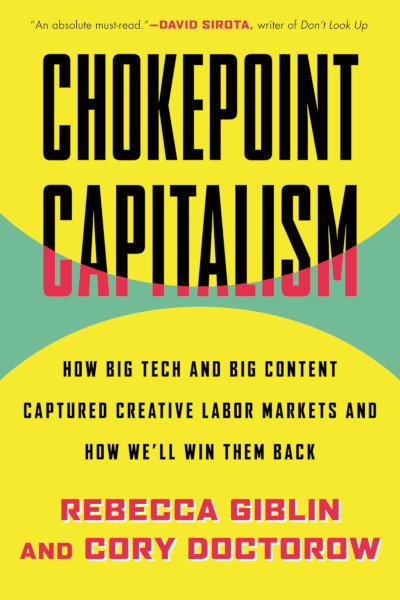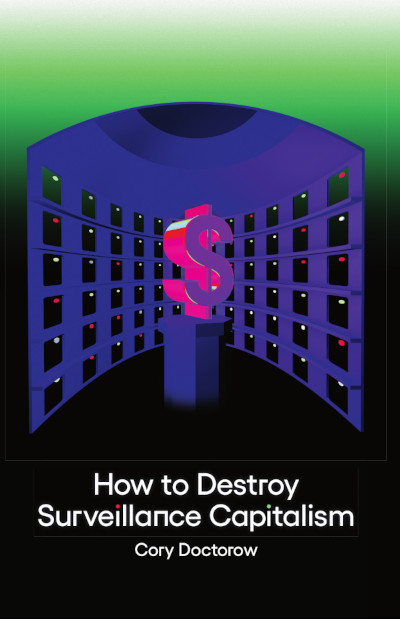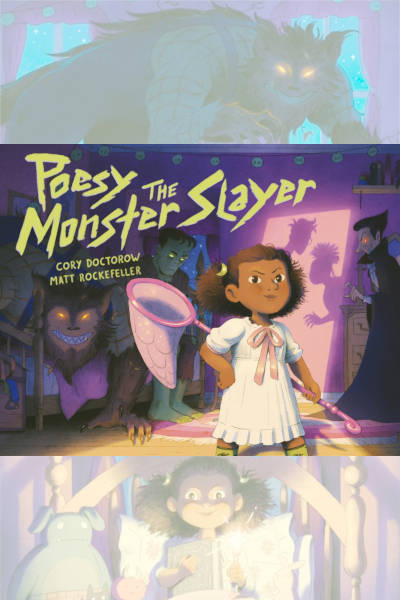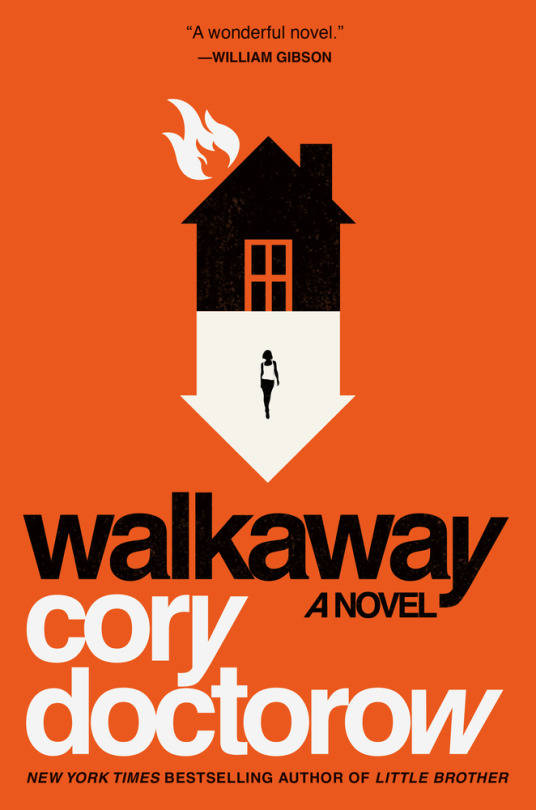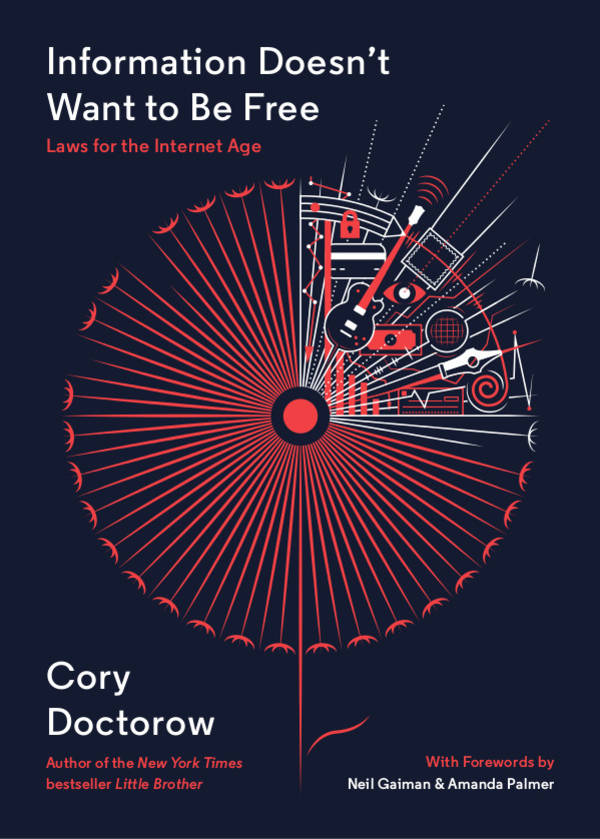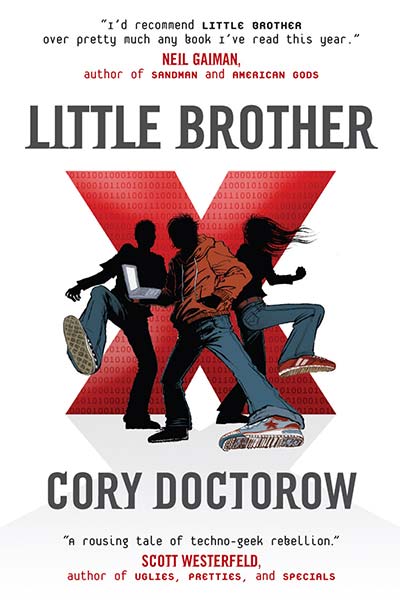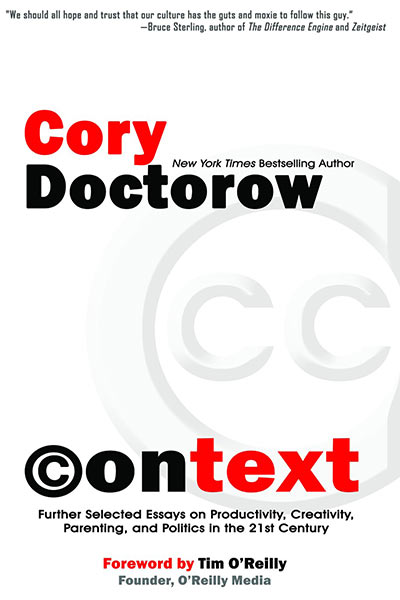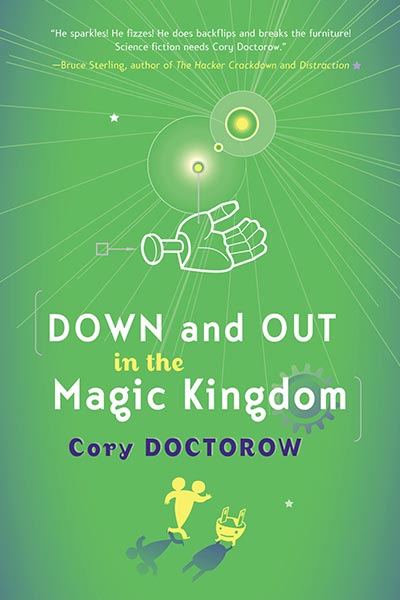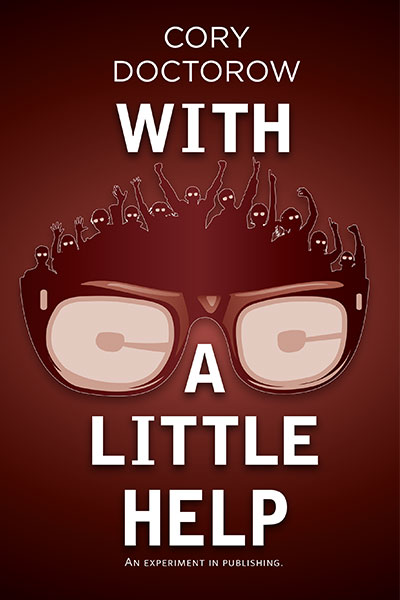I’ve got a old-fashioned link-blog, Pluralistic, where I post a daily list of links with commentary and analysis. If you’d prefer to get it as a newsletter, you can subscribe to the Plura-list. Both are free from surveillance and advertising.

This week on my podcast, I conclude my reading of my 2003 Asimov’s Science Fiction Magazine story, Nimby and the D-Hoppers” (here’s the first half). The story has been widely reprinted (it was first published online in The Infinite Matrix in 2008), and was translated (by Elisabeth Vonarburg) into French for Solaris Magazine, as well as into Chinese, Russian, Hebrew, and Italian. The story was adapted for my IDW comic book series Cory Doctorow’s Futuristic Tales of the Here and Now by Ben Templesmith. I read this into my podcast 20 years ago, but I found myself wanting to revisit it.
Don’t get me wrong — I like unspoiled wilderness. I like my sky clear and blue and my city free of the thunder of cars and jackhammers. I’m no technocrat. But goddamit, who wouldn’t want a fully automatic, laser-guided, armor-piercing, self-replenishing personal sidearm?
Nice turn of phrase, huh? I finally memorized it one night, from one of the hoppers, as he stood in my bedroom, pointing his hand-cannon at another hopper, enumerating its many charms: “This is a laser-guided blah blah blah. Throw down your arms and lace your fingers behind your head, blah blah blah.” I’d heard the same dialog nearly every day that month, whenever the dimension-hoppers catapaulted into my home, shot it up, smashed my window, dived into the street, and chased one another through my poor little shtetl, wreaking havoc, maiming bystanders, and then gateing out to another poor dimension to carry on there.
Assholes.
It was all I could do to keep my house well-fed on sand to replace the windows. Much more hopper invasion and I was going to have to extrude its legs and babayaga to the beach. Why the hell was it always my house, anyway?

This week on my podcast, I once again read my 2003 Asimov’s Science Fiction Magazine story, Nimby and the D-Hoppers” The story has been widely reprinted (it was first published online in The Infinite Matrix in 2008), and was translated (by Elisabeth Vonarburg) into French for Solaris Magazine, as well as into Chinese, Russian, Hebrew, and Italian. The story was adapted for my IDW comic book series Cory Doctorow’s Futuristic Tales of the Here and Now by Ben Templesmith. I read this into my podcast 20 years ago, but I found myself wanting to revisit it.
Don’t get me wrong — I like unspoiled wilderness. I like my sky clear and blue and my city free of the thunder of cars and jackhammers. I’m no technocrat. But goddamit, who wouldn’t want a fully automatic, laser-guided, armor-piercing, self-replenishing personal sidearm?
Nice turn of phrase, huh? I finally memorized it one night, from one of the hoppers, as he stood in my bedroom, pointing his hand-cannon at another hopper, enumerating its many charms: “This is a laser-guided blah blah blah. Throw down your arms and lace your fingers behind your head, blah blah blah.” I’d heard the same dialog nearly every day that month, whenever the dimension-hoppers catapaulted into my home, shot it up, smashed my window, dived into the street, and chased one another through my poor little shtetl, wreaking havoc, maiming bystanders, and then gateing out to another poor dimension to carry on there.
Assholes.
It was all I could do to keep my house well-fed on sand to replace the windows. Much more hopper invasion and I was going to have to extrude its legs and babayaga to the beach. Why the hell was it always my house, anyway?

This week on my podcast, I read Why I don’t like AI art, a column from last week’s Pluralistic newsletter:
Which brings me to art. As a working artist in his third decade of professional life, I’ve concluded that the point of art is to take a big, numinous, irreducible feeling that fills the artist’s mind, and attempt to infuse that feeling into some artistic vessel – a book, a painting, a song, a dance, a sculpture, etc – in the hopes that this work will cause a loose facsimile of that numinous, irreducible feeling to manifest in someone else’s mind.
Art, in other words, is an act of communication – and there you have the problem with AI art. As a writer, when I write a novel, I make tens – if not hundreds – of thousands of tiny decisions that are in service to this business of causing my big, irreducible, numinous feeling to materialize in your mind. Most of those decisions aren’t even conscious, but they are definitely decisions, and I don’t make them solely on the basis of probabilistic autocomplete. One of my novels may be good and it may be bad, but one thing is definitely is is rich in communicative intent. Every one of those microdecisions is an expression of artistic intent.
This week on my podcast, I read my latest Locus Magazine column, “There Were Always Enshittifiers,” about the historical context for my latest novel, Picks and Shovels:
It used to be a much fairer fight. It used to be that if a company figured out how to block copying its floppies, another company – or even just an individual tinkerer – could figure out how to break that “copy protection.” There were plenty of legitimate reasons to want to do this: Maybe you owned more than one computer, or maybe you were just worried that your floppy disk would degrade to the point of unreadability. That’s a very reasonable fear: Floppies were notoriously unreliable, and every smart computer user learned to make frequent backups against the day that your computer presented you with the dread DISK ERROR message.
In those early days, it was an arms race between companies that wanted to control how their customers used their own computers, and the technological guerrillas who produced the countermeasures that restored command over your computer to you, its owner. It’s true that the companies making the “copy protection” (in scare quotes because the way you protect your data is by making copies of it) typically had far more resources than the toolsmiths who were defending technology users.

Last night, I traveled to Toronto to deliver the annual Ursula Franklin Lecture at the University of Toronto’s Innis College. The lecture was called “With Great Power Came No Responsibility: How Enshittification Conquered the 21st Century and How We Can Overthrow It.” It’s the latest major speech in my series of talks on the subject, which started with last year’s McLuhan Lecture in Berlin, and continued with a summer Defcon keynote.
This speech specifically addresses the unique opportunities for disenshittification created by Trump’s rapid unscheduled midair disassembly of the international free trade system. The US used trade deals to force nearly every country in the world to adopt the IP laws that make enshittification possible, and maybe even inevitable. As Trump burns these trade deals to the ground, the rest of the world has an unprecedented opportunity to retaliate against American bullying by getting rid of these laws and producing the tools, devices and services that can protect every tech user (including Americans) from being ripped off by US Big Tech companies.
I’m so grateful for the chance to give this talk. I was hosted for the day by the Centre for Culture and Technology, which was founded by Marshall McLuhan, and is housed in the coach house he used for his office. The talk itself took place in Innis College, named for Harold Innis, who is definitely the thinking person’s Marshall McLuhan. What’s more, I was mentored by Innis’s daughter, Anne Innis Dagg, a radical, brilliant feminist biologist who pretty much invented the field of giraffology.
But with all respect due to Anne and her dad, Ursula Franklin is the thinking person’s Harold Innis. A brilliant scientist, activist and communicator who dedicated her life to the idea that the most important fact about a technology wasn’t what it did, but who it did it for and who it did it to. Getting to work out of McLuhan’s office to present a talk in Innis’s theater that was named after Franklin? Swoon!
Here’s the audio from the talk.

This week on my podcast, I bring you the audio from yesterday’s Jacobin virtual book launch for my book Picks and Shovels, with Yanis Varoufakis, hosted by David Moscrop. You have until Monday night to order personalized, signed copies of the book from Los Angeles’s Secret Headquarters (I’m dropping by the warehouse to sign them on Tuesday, on my way to my event at LA’s Diesel Bookstore with Wil Wheaton). See the whole tour schedule (20+ cities and still growing!) here.

This week on my podcast, I read MLMs are the mirror-world version of community organizing, a recent post from my Pluralistic newsletter.
MLMs prey on the poor and desperate: women, people of color, people in dying small towns and decaying rustbelt cities. It’s not just that these people are desperate – it’s that they only survive through networks of mutual aid. Poor women rely on other poor women to help with child care, marginalized people rely on one another for help with home maintenance, small loans, a place to crash after an eviction, or a place to park the RV you’re living out of.
In other words, people who lack monetary capital must rely on social capital for survival. That’s why MLMs target these people: an MLM is a system for destructively transforming social capital into monetary capital. MLMs exhort their members to mine their social relationships for “leads” and “customers” and to use the language of social solidarity (“women helping women”) to wheedle, guilt, and arm-twist people from your mutual aid network into buying things they don’t need and can’t afford.
But it’s worse, because what MLMs really sell is MLMs. The real purpose of an MLM sales call is to convince the “customer” to become an MLM salesperson, who owes you a share of every sale they make and is incentivized to buy stock they don’t need (from you) in order to make quotas. And of course, their real job is to sign up other salespeople to work under them, and so on.

Announcing the Picks and Shovels book tour (permalink)
My next novel, Picks and Shovels, is officially out in the US and Canada on Feb 17, and I’m about to leave on a 20+ city book-tour, which means there’s a nonzero chance I’ll be in a city near you between now and the end of the spring!
https://us.macmillan.com/books/9781250865908/picksandshovels
Picks and Shovels is a standalone novel starring Martin Hench – my hard-charging, two-fisted, high-tech forensic accountant – in his very first adventure, in the early 1980s. It’s a story about the Weird PC era, when no one was really certain what shape PCs should be, who should make them, who should buy them, and what they’re for. It features a commercial war between two very different PC companies.
The first one, Fidelity Computing, is a predatory multi-level marketing faith scam, run by a Mormon bishop, a Catholic priest, and an orthodox rabbi. Fidelity recruits people to exploit members of their faith communities by selling them third-rate PCs that are designed as rip-off lock-ins, forcing you to buy special floppies for their drives, special paper for their printers, and to use software that is incompatible with everything else in the world.
The second PC company is Computing Freedom, a rebel alliance of three former Fidelity Computing sales-managers: an orthodox woman who’s been rejected by her family after coming out as queer; a Mormon woman who’s rejected the Church over its opposition to the Equal Rights Amendment, and a nun who’s quit her order to join the Liberation Theology movement in the struggle for human rights in America’s dirty wars.
In the middle of it all is Martin Hench, coming of age in San Francisco during the PC bubble, going to Dead Kennedys shows, getting radicalized by ACT UP!, and falling in love – all while serving as CFO and consigliere to Computing Freedom, as a trade war turns into a shooting war, and they have to flee for their lives.
The book’s had fantastic early reviews, with endorsements from computer historians like Steven Levy (Hackers), Claire Evans (Broad-Band), John Markoff (What the Doormouse Said) and Dan’l Lewin (CEO of the Computer History Museum). Stephen Fry raved that he “hugely enjoyed” the “note perfect,” “superb” story.
And I’m about to leave on tour! I have nineteen confirmed dates, and two nearly confirmed dates, and there’s more to come! I hope you’ll consider joining me at one of these events. I’ve got a bunch of fantastic conversation partners joining me onstage and online, and the bookstores that are hosting me are some of my favorite indie booksellers in the world.
BOSTON (Feb 14):
Boskone, 4PM, Westin Boston Seaport District
https://schedule.boskone.org/62/
Brookline Booksmith with KEN LIU, 7PM, 279 Harvard Street, Brookline
https://brooklinebooksmith.com/event/2025-02-14/cory-doctorow-ken-liu-picks-and-shovels
VIRTUAL (Feb 15):
YANIS VAROUFAKIS, sponsored by Jacobin and hosted by David Moscrop, 10AM Pacific, 1PM Eastern, 6PM UK, 7PM CET
https://www.youtube.com/watch?v=xkIDep7Z4LM
MENLO PARK (Feb 17):
Kepler’s Books with CHARLIE JANE ANDERS, 7PM, 1010 El Camino Real
https://www.keplers.org/upcoming-events-internal/cory-doctorow
LOS ANGELES (Feb 18):
Diesel Bookstore with WIL WHEATON, 630PM, 225 26th Street, Santa Monica
https://www.dieselbookstore.com/event/Cory-Doctorow-Wil-Wheaton-Author-signing
SEATTLE (Feb 19):
Third Place Books with DAN SAVAGE, 7PM, 17171 Bothell Way Northeast #A101 Lake Forest Park
https://www.eventbrite.com/e/cory-doctorow-with-dan-savage-picks-and-shovels-a-martin-hench-novel-tickets-1106741957989
TORONTO (Feb 23):
Another Story, 630PM, 315 Roncesvalles Ave
https://www.eventbrite.ca/e/picks-shovels-cory-doctorow-tickets-1219803217259
NYC (Feb 26):
The Strand with JOHN HODGMAN, 7PM, 828 Broadway
https://www.eventbrite.com/e/cory-doctorow-john-hodgman-picks-and-shovels-tickets-1131132841779
PENN STATE (Feb 27):
Kern Auditorium, 7PM, 112 Kern Building
https://www.bellisario.psu.edu/assets/uploads/CoryDoctorow-Poster.pdf
DOYLESTOWN (Mar 1):
Doylestown Bookshop, 12PM, 16 S Main St
https://www.eventbrite.com/e/cory-doctorow-picks-and-shovels-a-martin-hench-novel-tickets-1146230880419
BALTIMORE (Mar 2):
Red Emma’s, 2PM, 630PM, 3128 Greenmount Ave
https://redemmas.org/events/cory-doctorow-presents-picks-and-shovels/
DC (Mar 4):
Cleveland Park Library with MATT STOLLER, 630PM, 3310 Connecticut Ave NW
https://www.loyaltybookstores.com/picksnshovels
RICHMOND (Mar 5):
Fountain Bookstore with LEE VINSEL, 6PM, 1312 E Cary St
https://fountainbookstore.com/events/1795820250305
AUSTIN (Mar 10):
First Light Books, 7PM, 4300 Speedway/43rd
https://thethirdplace.is/event/cory-doctorow-picks-shovels-1
BURBANK (Mar 13):
Dark Delicacies, 6PM, 822 N. Hollywood Way
https://www.darkdel.com/store/p3257/Thu%2C_Mar_13th_6_pm%3A_Pick_%26_Shovel%3A_A_Martin_Hench_Novel_HB.html#/
SAN DIEGO (Mar 24):
Mysterious Galaxy, 7PM, 3555 Rosecrans
https://www.mystgalaxy.com/32425Doctorow
BELFAST (Mar 24) (remote):
Imagine! Festival with ALAN MEBAN, 7PM UK
https://www.eventbrite.co.uk/e/cory-doctorow-in-conversation-with-alan-meban-tickets-1106421399189
CHICAGO, Apr 2:
Exile in Bookville with PETER SAGAL, 7PM, 410 S Michigan Ave, 2nd floor
https://exileinbookville.com/events/44853
BLOOMINGTON, Apr 4:
Morgenstern Books, 6PM, 642 N Madison St
https://morgensternbooks.com/event/2025-04-04/author-event-cory-doctorow
AUCKLAND, May 2
Unity Books, 19 High Street, 6PM
https://www.eventbrite.co.nz/e/an-evening-with-cory-doctorow-tickets-1320740102199
WELLINGTON, May 3,
Unity Books, 57 Willis Street, 3PM
https://www.unitybooks.co.nz/news-and-events/author-talk-picks-and-shovels-by-cory-doctorow
PITTSBURGH, May 15
White Whale Books, 4754 Liberty Avenue
https://whitewhalebookstore.com/events/20250515
PDX, Jun 20:
Barnes and Noble with BUNNIE HUANG, Lloyd Center
https://stores.barnesandnoble.com/event/9780062183697-0
LONDON, Jul 1
The Conduit with RILEY QUINN
6 Langley Street
https://howtoacademy.com/events/cory-doctorow-the-fight-against-the-big-tech-oligarchy/
MANCHESTER, Jul 2
Blackwell’s Bookshop, 146 Oxford Road
https://www.eventbrite.co.uk/e/an-evening-with-cory-doctorow-tickets-1308451968059
I really hope you’ll come out and say hello. I know these are tough times. Hanging out with nice people who care about the same stuff as you is a genuine tonic.

This week on my podcast, I read Canada shouldn’t retaliate with US tariffs, a recent post from my Pluralistic newsletter.
But you know what Canada could make? A Canadian App Store. That’s a store that Canadian software authors could use to sell Canadian apps to Canadian customers, charging, say, the standard payment processing fee of 5% rather than Apple’s 30%. Canada could make app stores for the Android, Playstation and Xbox, too.
There’s no reason that a Canadian app store would have to confine itself to Canadian software authors, either. Canadian app stores could offer 5% commissions on sales to US and global software authors, and provide jailbreaking kits that allows device owners all around the world to install the Canadian app stores where software authors don’t get ripped off by American Big Tech companies.

This week on my podcast, I’m reading “The Weight of a Feather (The Weight of a Heart),” my short story in Harlan Ellison’s The Last Dangerous Visions, commissioned by J. Michael Straczynski.
Margaret came into my office, breaking my unproductive clicktrance. She looked sheepish. “I got given one of those robots that follows you around,” she said. She took a step, revealing the waist-high reinforced cardboard box. “Want to help unbox?
I stood up and unkinked my spine and hips and shoulders with a sound like wringing out a sheet of bubble-wrap. “Oof.”
“Come on, old fella,” she said. She handed me a box-cutter.





